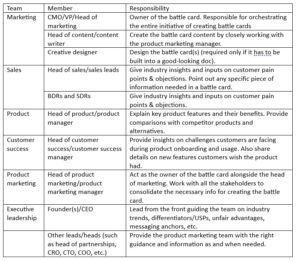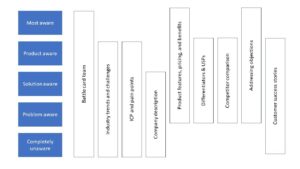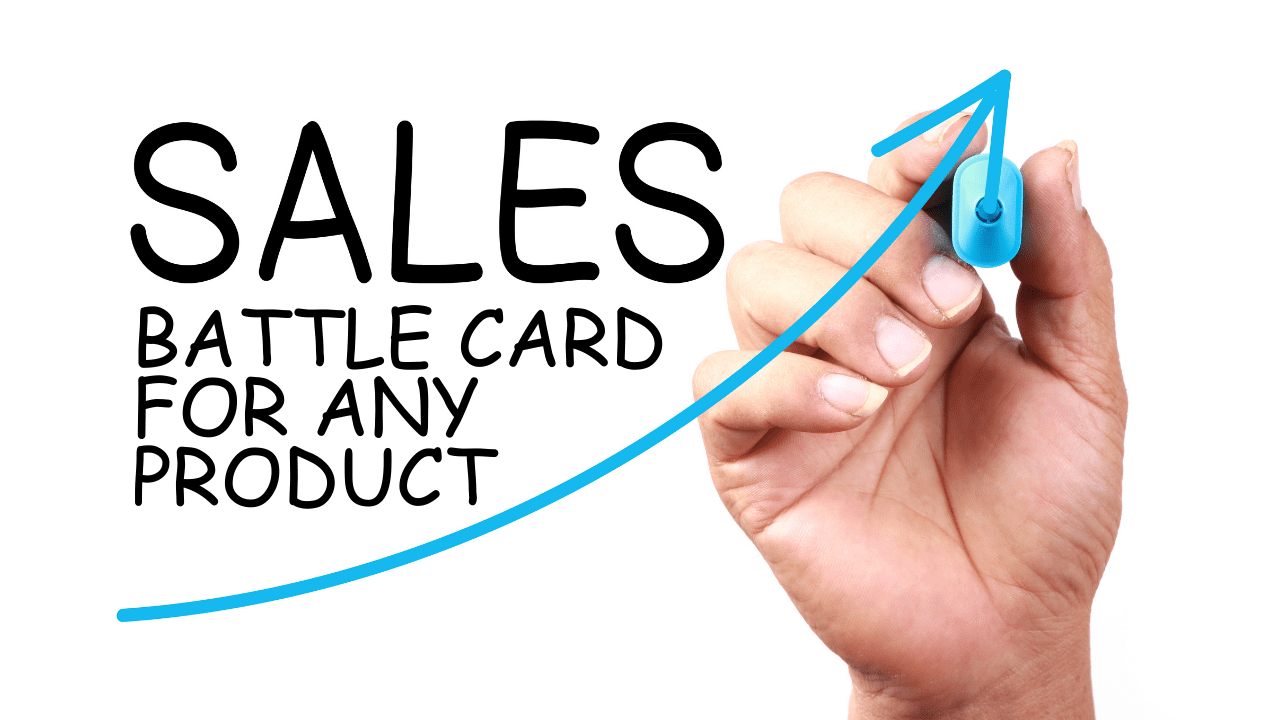This article was originally published in the Elevate Your Marketing newsletter and has been repurposed and republished here with the author’s permission. Here is the link to the original article.
Creating sales battle cards is one such activity that cuts across multiple functions such as product, sales, marketing, customer success, product marketing, etc. It calls for extensive collaboration between all these teams. Despite this, many companies fail to do a good job of creating a battle card that truly meets its purpose.
Hence, in this article, I share my thoughts on how you can put together a sales battle card for any product or solution – irrespective of your industry.
In the end, I will also be sharing a battle card template that you can start using right away. But make sure to go through the full content to be able to use the template effectively.
Busting the myths about sales battle cards
I personally believe that battle cards are a little overrated. Many get obsessed with the activity of creating it rather than the purpose it is meant for. I have seen many sales teams being absolutely clear about their positioning, messaging, and differentiators without having put together a battle card. Having that clarity is more important.
At the same time, for most salespeople, having their product’s USPs (Unique Selling Propositions) – and the other weapons they need during sales conversations – documented in the form of a sales battle card is an easier way to organize their thoughts.
So battle cards do help if you use them well.
In this section, I wanted to bust some of the other myths or misconceptions marketers and salespeople have about battle cards:
- Battle cards are not a single pamphlet-like document that outlines everything a salesperson needs. If you have a mature product or solution, you will need more than one battle card (we will talk more about the types later in this article).
- Battle cards aren’t lengthy documents that cover everything about a company’s product, its features, competitors, market trends, etc. Rather it is a concise document or piece of content of any kind that acts as a guiding light for a business that will help communicate the solution’s value to its prospects.
- Battle cards are not just for salespeople. It can help marketers, founders, or anyone in the company convey with ease the benefits of your solutions internally or externally.
- Battle cards are not just for the SaaS industry. The SaaS world made the term popular, but pretty much any company offering a service can create a battle card – only the components will vary depending on what you sell.
Sales battle cards for different stages of the buying journey
As I mentioned earlier, you might need different battle cards for different purposes. And my favorite way of visualizing it is to categorize it into different stages of the buying journey. For instance, if you are trying to use your strengths to generate demand for your business, you need a battle card that educates your audience on your product, or sometimes your category.
I know this goes against the conventional definition of what sales battle cards are. But imagine this.
You put hours and hours into creating a set of battle cards that have in-depth explanations about your company’s differentiated positioning. Why not leverage the same for all the stages of the customer journey?
To create battle cards, let us categorize the buying journey into the following stages that we all are familiar with:
- Completely unaware
- Problem aware
- Solution aware
- Product aware
- Most aware
So, do we need to create different battle cards for all 5 stages?
Well, it depends. It depends on whether you want to go that deep. What I mean here is that, if you wish to create a supporting battle card for each buying stage (which you can then leverage to create various content items such as landing pages, website copy, paid ads copy, etc.), I would recommend you to give that approach a shot.
On the other hand, if you do not wish to overcomplicate it and like to keep things simple, stick with one. But you need to make sure that the battle card contains all the necessary elements that would help you meet the needs of every type of customer. The template I discuss later in this article is built in a way that you can use for both approaches.
Steps involved in preparing a sales battle card
Let’s come to the core of the topic now. A battle card is your go-to place to know about those small pointers that will help you handle questions, objections, and negative feedback about your product or solution.
That said, the following are the steps you need to follow to create a battle card:

Steps involved in preparing a sales battle card
- Constitute a ‘battle card team’
- Research industry trends and challenges
- Define your ICP and their pain points
- Describe what your company does
- Explain product features, benefits, and pricing
- Differentiators and USPs
- List down the strengths and weaknesses of all the competitors
- Identify and address potential objections
- Tell customer success and product usage stories
Let us delve into the details of each next.
1. Constitute a ‘sales battle card team’
Creating a team doesn’t mean setting up a function. Battle cards once created only need to be updated once every 3 months or so (except for industry trends and objections). So you just need to have the right people working together on this for a specified duration. But don’t be like those companies that create battle cards only to be kept in the company’s SharePoint or content management system to be untouched.
Now, coming to the battle card team. Here is what it would constitute:

As you can see in the image, I have listed down all the teams and team members involved in the process of battle card creation along with their responsibilities.
It is to be noted here that the level of involvement from each team would entirely depend on how your company is structured. For example, in a large company with say 10000+ employees, collaborating across all these teams might be difficult. In such a case, you will have to limit the battle card team to a limited number of people.
On the other hand, in a startup, you could easily have all the people mentioned contribute to the process of battle card creation.
Note: I have added the above table in the battle card template so that you have the editable version of it.
2. Research industry (and product) trends and challenges
Why is it important to include industry trends in a battle card?
Knowing what is happening in the industry gives your customers and prospects a feeling that you are updated and are modifying your solutions accordingly. It will also help you spot newer challenges or pain points your solution is addressing.
For example, if you are selling an AI-based content repurposing tool like Vidyo, knowing that marketers can improve productivity by a certain percentage by using such tools can be used to your advantage during sales conversations and marketing campaigns.
3. Define your ICP and their pain points while creating sales battle cards
Properly defining your ICP is fundamental to any business. And it’s important when it comes to creating battle cards too.
Define your ICP along the following dimensions:
- Firmographic criteria of your target accounts: revenue, industry, sub-industry, region, number of employees, etc.
- Demographic criteria such as job title, designation, interests, etc.
Depending on the product you sell, there might be other criteria to consider, such as specific functions beyond the usual job title (e.g. network cybersecurity) and community membership (e.g. member of an industry forum on robotics).
You can also add additional details about your ICP here such as the market size, growth rate, future prospects, etc.
4. Describe what your company does
This is pretty straightforward. This essentially explains what your company does in a few sentences. Here are a couple of examples:
“{{company name}} offers a CRM software tailored specifically for the healthcare and life sciences industry in the US, UK, Canada, Europe, and Australia as focus geographies. The company primarily targets companies in the enterprise and midmarket segment with {{USP}} as a key differentiator.”
“{{company name}} is into selling robots for industrial and commercial use in warehouses, mines, factories, and construction sites.”
If you have the liberty, you can add details such as revenue, number of employees, headquarters, etc., to the above. Remember, the idea is not to make the battle card an exhaustive document, but rather like a sticky note that your salespeople and marketers can rely on for leading sales conversations and marketing activities.
5. Explain product features, benefits, and pricing
There are many frameworks you can use to describe the features and benefits of your product in the sales battle card. My favorite one is the FAB (Features, Advantages, and Benefits) framework.
- Features: this is where you explain the key features of your product or solution.
- Advantages: Here, you speak about the advantages your customers get by using your product.
- Benefits: these are short-term and long-term benefits customers can get using your products and solutions.
Let us understand this better using an example. Consider a company selling payroll software for startups and small businesses. For them, the FAB stack would look something like this:
- Features: our payroll software eases the process for companies and employees by automating the processes of salary disbursement, compliance, and related communication.
- Advantages: You don’t have to rely anymore on complex Excel sheets to compute employee salaries end of every month. You also get a single pane of glass to view all your employee payroll details.
- Benefits: By automating the entire payroll process, payroll, and HR managers can improve productivity by up to 30% by freeing up time from mundane activities, and get to focus more on business-critical and strategic tasks.
This is where you mention the pricing of your product too. You can also consider doing a comparison with your competitor products’ pricing here.
6. Adding differentiators and USPs to your sales battle cards
These, as you know, are the factors that set you apart from your competitors and other alternatives. Following are the items you need to include in this section:
- Target persona
- What your company offer for the persona
- Quantifiable unique value proposition
If you have multiple target audiences and each derives different benefits from your solutions, do this exercise for all of them.
7. List down the strengths and weaknesses of all the competitors
This is a must-add to your battle card. Depending on what you sell, you can design this in different ways. A popular way of doing it in the SaaS world is to list down all the features and compare them against alternatives.
I am referring to illustrations like the below:

You would have also seen those detailed comparison articles that go deep into every module and feature of competitor products. The HubSpot vs Salesforce article is an example of this.
Whatever format you follow, the idea is to be honest about it. Instead of trying to degrade your competitors, make the comparison respectfully by highlighting their strengths alongside their weaknesses. This establishes more trust in your brand and helps improve your brand equity over time.
8. Identify and address potential objections
Handling objections is one of the toughest things when it comes to sales conversations. This is one section in a sales battle card that you need to constantly update. Because you discover newer objections with almost every customer interaction.
One of the other common methods of discovering objections is by looking at reviews of your own product or competitor products. If you are relatively new to the business, you might not have too many reviews, in which case you could always turn to reviews and feedback on alternatives.
Websites like G2, Trustpilot, Capterra, etc., are some of the best places to find both positive and negative feedback about your solutions. While positive feedback can act as a reference for crafting the right messaging, negative feedback are source for you to identify areas of improvement and discover objections.
But don’t restrict yourself to review sites alone when it comes to finding objections.
Are there specialized forums in your niche where customers, partners, and vendors share their thoughts and opinions about your category? Tap into them to uncover objections that you might not have otherwise identified.
What about YouTube review videos of your products and competitor products?
Do you have the luxury of using a conversational intelligence platform like Gong or Chorus AI to analyze sales calls? Leverage them to unearth new objections.
You can also consume content online such as blogs, podcasts, webinars, etc., to understand the common challenges prospects and experts talk about concerning your product or category.
Consolidate all these, and make sure you have responses ready for each of them in your battle card.
Also read: How To Collect Customer Feedback And Integrate It Into Marketing?
9. Tell customer success and product usage stories
Following are some of the ways in which you can showcase customer success stories in a bottle card:
- Case studies
- Testimonials
- Product usage/customer story videos
- Positive reviews
If the content format is short, you can include them as is in a battle card. Or else, you can link to it by hosting it elsewhere.
Aligning the sales battle card with the B2B buying journey
Now that we understand the steps involved in building a battle card, the next thing to do is to align the battle card with different stages of the buying journey.
The below image illustrates how this can be done:

What I have done here is to align the 9 steps involved in creating a battle card with the relevant stages of the buying journey.
For example, the product features, pricing, and benefits element will not be relevant for prospects who are completely unaware. This is because they need to be first educated about the need itself. Introducing the product can only be done later once they are convinced that the problem exists.
Read this along with the battle card template. You will then be clearly able to understand and visualize this better.
How many sales battle cards should you have?
Depending on the depth you wish to go to, there are 3 ways in which you can create a battle card:
- A single document that explains the key components
- 1 battle card each for every stage of the customer journey
- 1 battle card to address a specific aspect (say 1 for product comparison, 1 for USPs, 1 for educating about your category).
Based on your objectives, you as a business can decide which one to go with. What I have done in the template given in the next section is to include all the necessary components that will help you create a battle card in any of the 3 ways.
Related: B2B Customer Journey Maps – How To Create Them & Make The Best Out Of Them
The sales battle card template and examples
If you understand the steps involved in building a sales battle card well, you are ready to get started with the battle card template right away. Here is the link to the template: Battle card template
Please note that the battle card template needs to be only used as a document to consolidate all the information required. To make it into a beautiful PDF or PPT file, you can take the help of a designer.
Here are a few samples you can draw inspiration from for the design process.
Final words about sales battle cards
Instead of defining only one right way of creating a battle card, I thought it makes sense to adopt a flexible approach that will equip you to create one that suits your business needs.
And as I mentioned in the beginning, don’t limit the use of battle cards only to sales conversations. Use it to:
- Finetune your marketing messaging
- Enhance internal brainstorming sessions
- Come up with new content creation ideas
- Discover new product features
In essence, use sales battle cards to improve your business and products.
Skalegrow – B2B marketing agency focused on your growth
With marketing getting tougher and tougher, every wrong foot you make might hamper your growth. What you need is the right guidance and a helping hand. This is where Skalegrow can make a sea of difference.
Skalegrow helps IT, tech, SaaS, and embedded systems companies leverage new-age marketing tactics to grow their business. Check out the below intro video to learn more about what Skalegrow brings to the table:
Alternatively, you can visit our services page or write to us at info@skalegrow.com.
About the author

Naseef KPO is the Founder and CEO of Skalegrow. He comes with rich experience across multiple areas of B2B marketing including content marketing, demand generation, SEO, account-based marketing, marketing analytics, revenue attribution, marketing technology, etc. He writes thought-provoking and relevant articles on The Skalegrow Blog and his weekly LinkedIn newsletter Elevate Your Marketing.
Prior to starting Skalegrow, Naseef led large marketing teams in multi-million dollar B2B organizations where he made significant contributions to the topline growth of the business. He has also appeared on numerous podcasts where he shared his thoughts on trending marketing topics such as the application of AI in marketing, startup marketing, ABM, and B2B content marketing, just to name a few. Being the founder of Skalegrow, he is currently focusing on helping its clients stay ahead of their competition by using innovative yet practical marketing tactics.
You can connect with Naseef KPO on LinkedIn.


